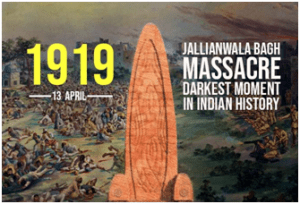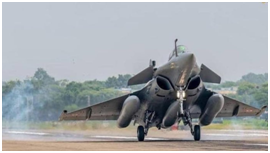FREEDOM STRUGGLE- MODERN INDIA
1. JALLIANWALA BAGH MASSACRE
TAGS: GS-I- HISTORY-PRELIMS
THE CONTEXT: This year marks the 104th anniversary of the Jallianwala Bagh Massacre, also known as the Amritsar Massacre. Check this article to know the answers to all your questions related to the heart-wrenching event of the Indian Freedom Struggle.
THE EXPLANATION:
- On April 13, 1919, what was planned as a protest gathering of Indians in a compound called Jallianwala Bagh in Amritsar, Punjab, in then British-ruled India, witnessed violence that would become one of the most lasting memories of the barbarity of colonial rule.
What is Jallianwala Bagh Massacre?
- The mass killing at Jallianwala Bagh took place on April 13, 1919, in Amritsar, Punjab, which later came to be known as the Amritsar massacre or Jallianwala Bagh massacre. To protest the Rowlatt Act and the detention of pro-independence activists Saifuddin Kitchlew and Satyapal, a large, peaceful crowd gathered at the Jallianwala Bagh in Amritsar. In response to the gathering, the British Indian Army’s temporary brigadier general R. E. H. Dyer covered the protesters with Gurkha, Baloch, Rajput, and Sikh soldiers from the 2-9th Gurkhas, the 54th Sikhs, and the 59th Scinde Rifles.
- The Jallianwala Bagh had only one exit because the other three were blocked by structures. Without giving the mob a chance to disperse, Dyer closed the main exits. He gave the order for his soldiers to start firing at the densest groups of people in front of the few possible small entrances, as terrified multitudes were attempting to flee the Bagh.
- A total of 1650 rounds were discharged throughout the 10-15 minute period of shooting. Up until they ran out of ammunition, the soldiers continued to fire. General Dyer and Mr Irving assessed a total death toll of 291 people. However, according to other sources, including one from a committee led by Madan Mohan Malviya, there were around 500 or more fatalities.
POLITY AND GOVERNANCE
2. DOCTRINE OF PROMISSORY ESTOPPEL
TAGS: GS-II- POLITY AND GOVERNANCE
THE CONTEXT:Recently, Advocate Prashant Bhushan argued that instead of implementing the Agnipath scheme, the government should complete the old process and cited the doctrine of promissory estoppel.
THE EXPLANATION:
About Doctrine of promissory estoppel:-
- The Doctrine of Promissory Estoppel works on the principle of equity, fairness and moral conscience.
- The doctrine of Promissory Estoppel means when an individual with an intention of forming a relationship which is lawful makes a clear promise to another individual and the latter individual acts on it, that promise becomes an obligation for the individual who made the promise.
- Hence, then going back from its words is not permissible.
- The law commission recommended suggestions to form a new section as Section 25A in the Indian Contract Act in the 108th report for this doctrine.
- No provisions as such are there which ensures availability of relief under this doctrine.
- At the same time, it can be implemented on the basis of equity, to defend the aggrieved party.
- The doctrine of estoppel in India is a rule of evidence included into Section 115 of The Indian Evidence Act, 1872.
- Promissory Estoppel’s application can invalidate the constitutional provision provided under Article 299, which talks about immunity granted against the personal accountability of an individual making the promise.
GOVERNMENT SCHEMES AND INTERVENTIONS
3. VIBRANT VILLAGES PROGRAMME
TAGS: GS-II GOVERNMENT SCHEMES AND INTERVENTIONS
THE CONTEXT:Recently, Union Home Minister launched the ‘Vibrant Villages Programme’ (VVP) in the border village of Kibithoo in Arunachal Pradesh. The constant threat along the country’s border amid the ongoing standoff with China has led to a concerted push to upgrade infrastructure in the border areas.
THE EXPLANATION:
What is the ‘Vibrant Villages Programme’?
- This village development scheme was first announced in the 2022 Budget. The programme’s targets are to provide comprehensive development of villages on the border with China and improvement in the quality of life of people living in identified border villages.
- The development in these villages will help prevent migration, and thus also boost security.
- The Parliamentary Standing Committee in 2018 had pointed towards backwardness, illiteracy, and lack of basic facilities and infrastructure in our border areas. The VVP aims to address all these issues.
What are the objectives of the scheme?
- The aims of the scheme are to identify and develop the economic drivers based on local, natural, human and other resources of the border villages, as per a press release by the Ministry of Home Affairs on February 15, 2023.
- Development of growth centres on the “Hub and Spoke Model” through promotion of social entrepreneurship, empowerment of youth and women through skill development is also one of the objectives of VVP.
- Moreover, the programme also intends to leverage tourism potential through promotion of local, cultural, traditional knowledge and heritage in the border areas, thus increasing the employment opportunities of the people and, as a result, stemming migration.
- Development of sustainable eco-agribusinesses on the concept of “One village-One product” through community-based organisations, cooperatives, SHGs, NGOs etc is also aimed at.
- The scheme envisages that drinking water, 24×7 electricity, connectivity with all weather roads, cooking gas, mobile and internet connectivity be made available in the border areas. Special attention will be given to solar and wind energy, tourist centres, multi-purpose centres and health infrastructure and wellness centres.
Which states come under VVP?
- Under this centrally sponsored scheme, 2,967 villages in 46 blocks of 19 districts have been identified for comprehensive development. These villages abut the border in the states of Arunachal Pradesh, Sikkim, Uttarakhand and Himachal Pradesh and the Union Territory of Ladakh. In the first phase, around 662 villages have been identified for priority coverage.
PRELIMS PERSPECTIVE
4. GOND PAINTING
TAGS: PRELIMS PERSPECTIVE
THE CONTEXT:Madhya Pradesh’s famous Gond paintings has received the prestigious Geographical Indication (GI) tag. A geographical Indication (GI) tag is a label placed on products that have a specific geographical origin and have traits or a reputation originating from that origin.
THE EXPLANATION:
- Madhya Pradesh’s artform of Gond Painting has been given the Geographical Indication (GI) tag by the Ministry of Commerce & Industry. A GI tag is essentially a name or sign given to products that are attached to a specific geographical location, which may include a region, town or country. GI tags ensure that only the registered or authorised user uses the name of the concerned product.
- Gond painting is a form of folk art by the Gond tribal community, which mostly inhabit parts of central India. Traditionally, Gond paintings were done on walls and floors of houses, and featured images of animals and plants as well as traditional geometric patterns. Gond paintings usually feature bright colours derived from natural resources.
VALUE ADDITION:
What is a geographical indication?
- A geographical indication (GI) is a sign used on products that have a specific geographical origin and possess qualities or a reputation that are due to that origin. In order to function as a GI, a sign must identify a product as originating in a given place.
- In addition, the qualities, characteristics or reputation of the product should be essentially due to the place of origin. Since the qualities depend on the geographical place of production, there is a clear link between the product and its original place of production.
5. EXERCISE ORION
THE CONTEXT: In the first overseas exercise for the Rafale fighter jets of the Indian Air Force (IAF), four Rafales will depart to France to take part in multilateral exercise Orion at Mont-de-Marsan, an Air Force base of the French Air and Space Force (FASF).
THE EXPLANATION:
- The exercise will be conducted from April 17 to May 5, with the IAF contingent comprising four Rafale, two C-17, two ll-78 aircraft and 165 personnel. “Participation in this exercise would further enrich the employment philosophy of the IAF, by imbibing the best practices from other Air Forces.”
- Ex Orion is one the largest exercises held by France in recent times involving around 12,000 troops, including those from North Atlantic Treaty Organisation and being held in four phases.
- Besides the IAF and the FASF, Air Forces from Germany, Greece, Italy, Netherlands, Spain, U.K. and U.S. would also be flying in this multilateral exercise.

